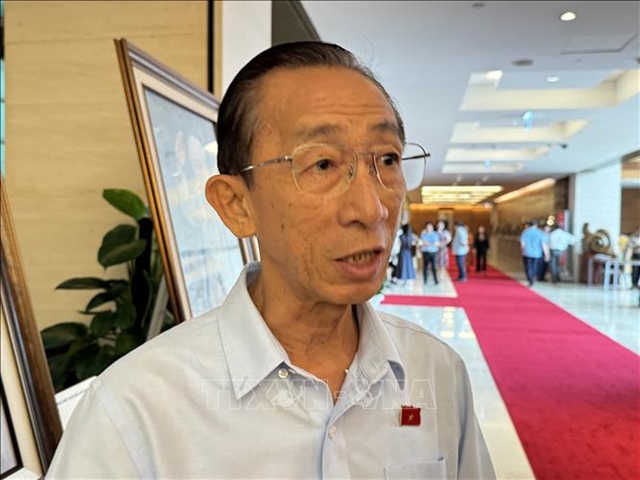 Opinion
Opinion

 |
| Associate Professor, Doctor of Economics, National Assembly Deputy Trần Hoàng Ngân. VNA/VNS Photo |
Việt Nam plans to set up international financial centres in HCM City and Đà Nẵng. The Government is committed to building a breakthrough legal corridor complying with the international laws and standards. Vietnam News Agency talks with Associate Professor, Doctor of Economics, National Assembly Deputy Trần Hoàng Ngân about the issue.
What is your opinion about the establishment of the financial centres?
The drafting committee has seriously listened to the opinions of experts and is approaching many international financial centres in the world.
With the conclusion of the Politburo and information from the Government, Việt Nam will have international financial centers located in HCM City and Đà Nẵng.
Currently, HCM City has been ranked by international organisations as one of the global financial centres and is ranked 98 out of 121 financial centres in the world.
However, becoming an international financial centre requires five key pillars. First is institution and business environment. This pillar must create investors confidence with integrated, transparent institutions and open, preferential business conditions to be able to compete and attract investors.
At present, the National Assembly and Government have institutionalised the Party’s resolutions and guidelines, especially the Politburo's Resolution 66-NQ/TW on renovating law making and enforcement meeting the country's development in the new era.
Along with that, the institution pillar must be ready to apply international laws to solve disputes in international financial centres.
The second pillar concerns infrastructure, encompassing the entire socio-economic infrastructure system, including transport and energy infrastructure, particularly that which supports the operation of an international financial centre — requiring speed, precision and efficiency. Investment in this area, especially public investment, is currently receiving significant attention.
The third pillar is human resources. HCM City has a long-established commercial banking system, dating back to 1987. Additionally, the HCM City Stock Exchange has operated since 2000, with 25 years of experience.
Furthermore, universities are focusing heavily on training students in this field. As a result, Việt Nam has a rich supply of human resources in finance, which is a considerable advantage for establishing an international financial centre.
The next pillar involves the banking and financial systems, and the network of financial institutions. HCM City currently has about 35 commercial banks, including domestic branches and nine foreign banks with nearly 320 branches.
The city is also home to seven State-owned commercial banks, 30 securities companies, 30 investment funds, and nearly 30 insurance organisations.
Importantly, there are nearly ten million securities investor accounts in the city.
Thus, the city's financial institutional ecosystem is in place and ready to contribute to the international financial centre.
The fifth pillar is branding. At present, the national brand of Việt Nam holds a strong and reputable position in the international market. The brand value of HCM City contributes to its prestige.
Although a formal decision has yet to be made on the establishment of the HCM City International Financial Centre, the city has already been ranked among the global financial centres.
I believed these five pillars will lay the groundwork for the development of an international financial centre in the near future.
What does HCM City need to stand side-by-side with global financial centres?
To compete with international financial centres in the world, the city must differentiate itself.
At present, the city is making substantial investments in science, technology, and innovation. The city has more than 2,200 start-ups. Recently, it was ranked 110th out of 1,400 cities globally in terms of the number of innovative start-ups.
This provides a platform for the international financial centre, where start-ups can raise capital from the market.
Consequently, the city has the opportunity to attract venture capital funds from around the world.
The primary goal of the Politburo and the Government in supporting the international financial centre is to mobilise capital to boost national economic development.
Therefore, the financial centre will serve as a hub for issuing urban and government bonds to raise funds globally.
This capital will be channeled into high-speed rail systems and urban rail networks in HCM City as well as Hà Nội.
Is there a need to establish additional international financial centres in other localities besides HCM City and Đà Nẵng?
Establishing an international financial centre in HCM City does not mean it will only serve the city.
Rather, it is a national-level centre intended to attract global attention and investment.
Other localities across the country can also participate in and benefit from this financial centre, using it as a platform to raise capital for their own development projects via the HCM City and Đà Nẵng financial centres. These matters will be detailed in Government regulations once the National Assembly passes the relevant resolution.
What are the biggest challenges in establishing international financial centres in the two cities?
One of the most significant challenges is that the Vietnamese đồng is not yet a strong and fully convertible currency. Việt Nam has not yet liberalised its capital account, so this will take time and require clear regulatory frameworks.
As such, banks need to have well-defined foreign exchange policies and regulations so that both market participants and external stakeholders can clearly understand and follow them.
Lastly, the most important factor for attracting international investors is the issue of arbitration and dispute resolution. Việt Nam will need to consider adopting international laws or common law principles — a legal system based on case law and court rulings in specific cases.
The Vietnamese State must guarantee the rights and interests of investors. If so, investors will have confidence in the country's transparent and robust legal framework.
With that foundation, Việt Nam is well-positioned to attract international investors to participate in its financial centre initiatives. VNS




